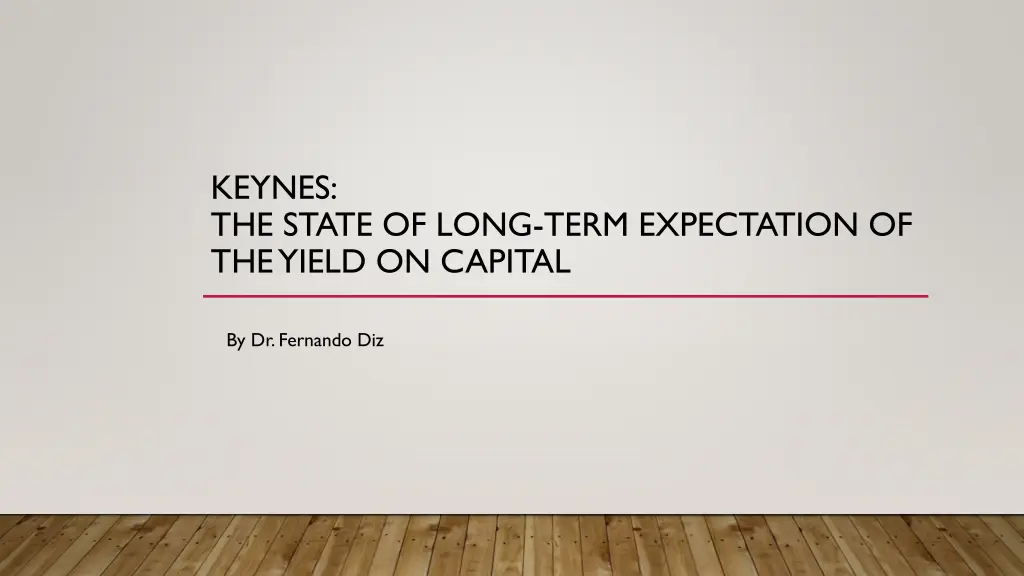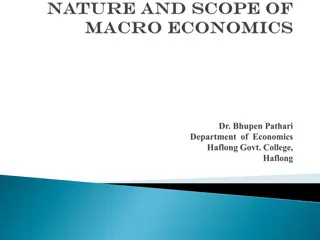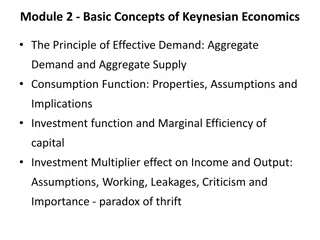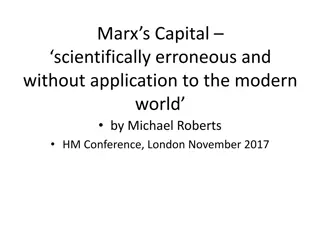
Understanding Long-Term Expectations of Yield on Capital
Explore the complex factors influencing prospective yield on capital, including existing facts and uncertain future events. Delve into the precarious nature of estimating prospective yields and the impact of security markets on investment decisions in both private and publicly traded businesses.
Download Presentation

Please find below an Image/Link to download the presentation.
The content on the website is provided AS IS for your information and personal use only. It may not be sold, licensed, or shared on other websites without obtaining consent from the author. If you encounter any issues during the download, it is possible that the publisher has removed the file from their server.
You are allowed to download the files provided on this website for personal or commercial use, subject to the condition that they are used lawfully. All files are the property of their respective owners.
The content on the website is provided AS IS for your information and personal use only. It may not be sold, licensed, or shared on other websites without obtaining consent from the author.
E N D
Presentation Transcript
KEYNES: THE STATE OF LONG-TERM EXPECTATION OF THE YIELD ON CAPITAL By Dr. Fernando Diz
PROSPECTIVE YIELD ON CAPITAL The considerations upon which expectations of prospective yield on capital are based are: Partly existing facts (stock of capital; i.e. existing assets, the strength of consumer demand, etc.) Partly future events which can only be forecasted with more-or-less confidence (changes in the stock of capital, tastes of the consumer, etc.)
PROSPECTIVE YIELD ON CAPITAL In forming our expectations we are guided by: Facts about which we feel somewhat confident (for example, the historical record of profitability, even though they may be less decisively relevant) and, Other facts for which our knowledge is vague (for example is TikTok going to steal customers from Instagram and render META less profitable?) This is why, the facts for the existing situation enter, in a sense disproportionately, into the formation of our long-term expectation.
FACT #1 Notice the Extreme precariousness of the basis of knowledge on which our estimates of prospective yields must be made.
INVESTMENT DECISION IN PRIVATE BUSINESSES (CONTRASTING THE PRIVATE BUSINESS TO THE PUBLICLY TRADED BUSINESS) Decisions to invest in PRIVATE business: Largely irrevocable for the community Largely irrevocable for the individual In the absence of security markets, there is no object in frequently attempting to revalue an investment to which we are committed.
INTRODUCTION OF SECURITY MARKETS (PROVIDE MARKETABILITY TO SECURITIES) Facilitate transfers of old investments between one individual and another, Provides for frequent revaluations of investments Exerts an important influence on the rate of current investment (why?): No sense in building up a new enterprise at a cost greater than that at which it can be purchased in the security markets (LBOs, going privates in general, share repurchases). There is an inducement to spend on a new project what may seem an extravagant sum, if it can be floated on a stock exchange. (Alibaba, Facebook, Twitter, etc.)
HOW ARE THESE REVALUATIONS CARRIED OUT? We assume that the existing market valuation is correct (see Soros discussion about reflexivity contesting this, and Whitman-Diz challenging this equilibrium pricing idea). The assumption is reinforced by EMH, efficient market hypothesis. So, we assume a correct valuation in relation to our existing knowledge of the facts which will influence the yield on investment , and that it will only change in proportion to changes in this knowledge. Note how important our departure points are: i) Valuation is correct and ii) it changes only in proportion to changes in this knowledge.
THE SAFE PERCEPTION If we can maintain this convention, one can encourage oneself with the idea that the only risk one runs is that of a genuine change in the news in the near-future. Then, the investment becomes reasonably safe over short periods, however many, if one can fairly rely on there being no breakdown in the convention.
Bloomberg news on January 30, 2023
WEAKNESSES IN THE CONVENTION 1. The element of real knowledge in the valuation of investments by those who own them has seriously declined. (as a result of an increase in the proportion of equity which is owned by persons who do not manage and have no special knowledge of the business). Robin Hood? 2. A conventional valuation which is established as the outcome of the mass psychology of a large number of ignorant individuals is liable to change violently as a result of a sudden change of opinion due to factors which do not really make much difference to the prospective yield, since there will be no strong roots of conviction to hold it steady. Opportunities to us?
WEAKNESSES IN THE CONVENTION 3. The professionals are forced to concern themselves with the anticipation of impending changes, in the news or sentiment of the kind by which experience shows that the mass psychology of the market is most influenced. In other words, professionals are concerned, not with what an investment is really worth to a man who buys it for keeps , but with what the market will value it, under the influence of mass psychology in the near future. (short-termism). Familiar? Price targets, earnings forecasts, earnings surprises, P/E pricing, etc.






















